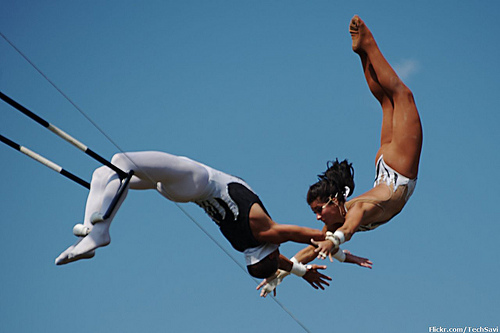Matt is one of our fantastic massage therapists at milk + honey spa 2nd Street District.
Have you ever been on the massage table, and your therapist scoops up one of your limbs, cradling it in the palms of her hands, and suddenly she says, “OK, just let it go”? This seems incongruent. You thought you already were relaxed. Let go of what?
Well, let go of your arm, your leg, or your head, of course. To be fair, “let go” is one of those countless phrases that often assumes more than it communicates. Its utterance assumes awareness and understanding, at the precise moment of its opposite’s presentation. The opposite of letting go is, of course, holding on.
In my opinion, due to its vagueness, telling someone to “let it go” or “let go” is about as useful as telling them, “NASA found water on Mars,” and yet I myself am tempted to use this phrase. Usually the therapist attempts to take a limb through a range of motion and/or to reposition the client to gain access to a work area. The client unconsciously halts the action. They either directly resist it or try to help the therapist, which is unnecessary. From the therapist’s point of view, the client really is fighting the movement. From the client’s point of view, they’re probably thinking, “Dinner could be any number of things, the kids need picking up, and that feels pretty good … Oh, wait? Let go of what?”
Once we figure out what “letting go” means, we may see its worth. I advocate it as a worthy enterprise of practice and development. Holding takes place in the muscles and mind. If we could let go of our holding, we would gain an enormous measure of peace, and also get more out of our massages. We want to develop the skill of letting go, because letting go is indicated when holding on inhibits therapeutic or otherwise positive development. As therapists, we want to avoid triggering the “hold on” response.
I argue that both the fault and the solution lies within both the practitioner’s and client’s realm of control. In studying this phenomenon after a while, I discovered at least a few theories, and a few ideas for dealing with it. From my observations I believe the clashing of movement at the massage table results from specific client and therapist modes.
The client doesn’t have the awareness or skills to let go. It may also be that they don’t trust their therapist, have let their attention go elsewhere, or are under too much stress. In short, they haven’t done their homework. The therapist on the other hand has triggered unconscious alarms in the client’s body. Basically the client is either too “switched off” or too sensitive, and/or the therapist is too abrupt, checked out, or is using an ineffective posture.
First, let’s take a look at our physiology. Proprioception is one of our hidden senses. It refers to awareness of our body in space. It’s kind of like a cross between touch and equilibrium, and is what allows you to know where your arm is when you raise it over your head, even though you can’t see it. Specialized cells called proprioceptors, mostly located around the joints, provide this service for you, but you can develop this sense if you want to. Other specialized cells like stretch and pressure receptors, tell us the relative tension of the tendons and ligaments. Finally our nervous system interprets and scales any change of sensory input, such as touch, change of position, sound, or lighting.
The inclination to resist movement must partially relate to our deeply ingrained fear of falling. Usually you stop yourself from even beginning to fall, and the experience almost always resides below consciousness. We also have another unconscious desire to inhibit any movement that overly challenges our joints. I don’t think it provides the same level of fear, but it factors in. Relegating the management of a change in environment, as communicated by a change in senses, to an unconscious level makes sense from a survival perspective as well. If those changes challenge the individual’s survival needs, a reaction is appropriate.
I suspect these biological conditions provide our venue for client/therapist failure. Both of us must work to inhibit these responses.
If I might overstep my scope, I think therapists must know how to create a space of safety. For a massage therapist this means we communicate. We don’t engage the fear of falling or the resistance to joint torque. We must provide the base that supports any manipulation we do. Deep horse stances and T-stances that support our physical center are necessary when we stand beneath the client’s limb. In this manner, we lend our clients a center of balance for movement to occur in their body, and no sense of falling. Secondly, we can expand our attention to encompass the full joint and limbs in our movement. If we approach transitions gently, and manage to minimize our own physical stress and efforts, we could probably defuse most resistance at the table.
Now for the client. It isn’t your fault that you unconsciously don’t want to be controlled by another individual. In fact, the pervasiveness of this habit suggests it’s a universal survival utility. Getting a massage shouldn’t be one of those times when survival instincts are firing though. In my experience, massage is a “co-creative” process. In other words, to the extent that a client is prepared to receive the massage, is the extent to which he or she will derive benefit from massage. Client and therapist should always be on the same side of a goal and the approach to that goal.
Client preparation may include physical, behavioral, and mental preparation. This may mean showing up to session early, taking a shower, stretching, reading, or agreeing to rest your worries on the floor as you receive. If I had to guess, being prepared to let go of your personal narratives would help the most. Write down your to-do lists if you must, but don’t bring them to the table. It may require a deeper practice and mind set.
You can physically learn how to let go by raising your arms and letting them drop of their own accord. You may need to convince yourself that it’s OK to take time off for your own care and maintenance. Knowing what you want from your massage and being able to communicate that will defuse quite a bit of anxiety. Of course in the extreme, no massage therapist worth their salt will violate boundaries by working the breasts or genitalia (we don’t consider the glutes to be a no-touch zone), but you should set boundaries ahead of time for yourself anyway. I think it’s a lot easier to relax if you’ve already decided what constitutes a deal-breaking breech of comfort. It feels empowering to take responsibility for your own sense of safety.
At the heart of this exchange is the relative ability to relinquish control as a client, and provide a safe place as a therapist. It requires practice, communication, a benefit of the doubt, and a little risk, to step out of our habitual holding and controlling, but in my opinion it’s worth it.



No Comments